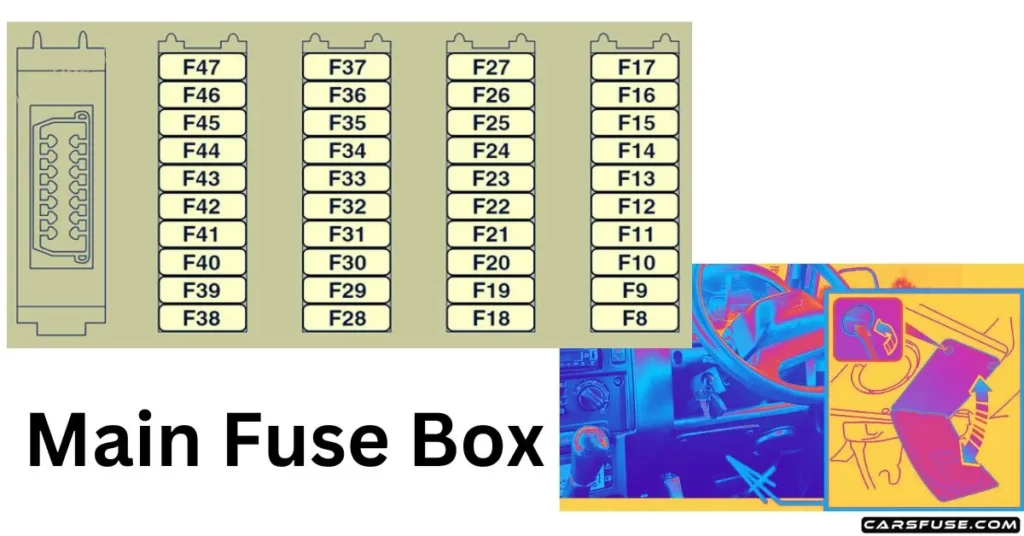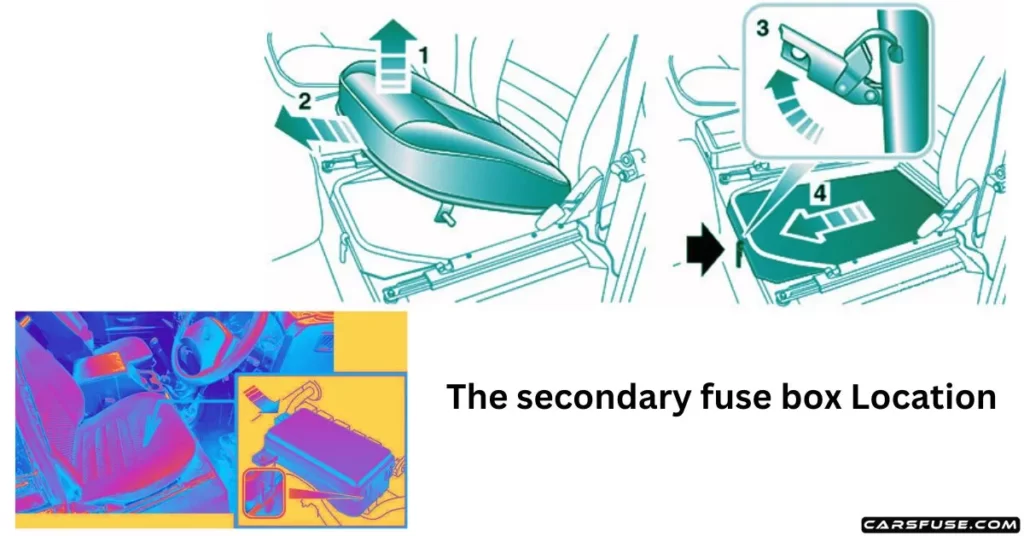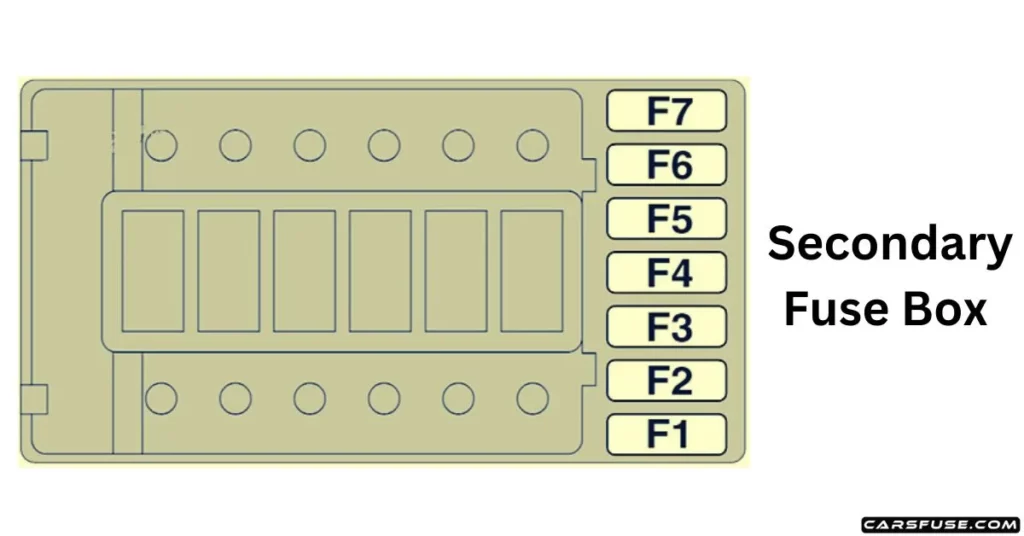The Land Rover Defender is a rugged and capable off-road vehicle that has been in production for over 70 years. It is known for its reliability and durability, and its simple yet effective electrical system is a big part of that.
The Defender has two fuse boxes: one located under the right-hand front seat and the other located below the steering wheel. The fuse boxes contain fuses that protect the electrical circuits in the vehicle. If a fuse blows, it will prevent damage to the circuit.
This article provides fuse box diagrams for the 2007-2011 Land Rover Defender. The diagrams show the location of each fuse in the fuse boxes, as well as the amperage rating of each fuse.
Table of Contents
Land Rover Defender Fuse Box Diagram (Main Fuse Box)
The primary fuse box is positioned beneath the steering column, slightly to the side. To reach the fuses, uncover them by completely turning the fastening screws in a counterclockwise direction.

| Fuse Number | Fuse Amp. Rating | Protected Components |
|---|---|---|
| F8 | 10A | Alarm system |
| F9 | 15A | Front wipers/wash |
| F10 | 10A | Rear wipers/wash |
| F11 | 10A | Anti-lock brakes |
| F12 | 10A | Speed transducer |
| F13 | 10A | Brake lamps |
| F14 | 10A | Reverse lamps |
| F15 | 5A | Ignition |
| F16 | – | Not used |
| F17 | – | Not used |
| F18 | 10A | Side lamps (left) |
| F19 | 10A | Side lamps (right) |
| F20 | 10A | lllumination/clock illumination |
| F21 | 10A | Hazard switch |
| F22 | 10A | Headlamp dipped beam (right) |
| F23 | 10A | Headlamp dipped beam (left) |
| F24 | 10A | Headlamp main beam (right) |
| F25 | 10A | Headlamp main beam (left) |
| F26 | 10A | Rear fog lamps |
| F27 | 10A | Alarm sounder |
| F28 | 20A | Heated rear window |
| F29 | 20A | Cooling fan / A/C clutch link |
| F30 | 10A | Audio/clock/diagnostic socket |
| F31 | 15A | Hazard switch |
| F32 | – | Not used |
| F33 | 20A | Seat heater |
| F34 | 20A | Electric window (right) |
| F35 | 20A | Electric window (left) |
| F36 | 30A | Heated front screen |
| F37 | 30A | Spare fuse |
| F38 | 10A | Engine ECU/PCM |
| F39 | 5A | Engine ECU/PCM |
| F40 | – | Not used |
| F41 | 5A | Engine ECU/PCM |
| F42 | 10A | Air conditioning switch |
| F43 | 20A | Cigar lighter |
| F44 | 5A | Audio unit |
| F45 | 30A | Blower motor |
| F46 | – | Not used |
| F47 | – | Not used |

Extract the seat base using the steps outlined below:
- Grip the front of the seat base securely and lift upwards to disengage from the holding clips.
- Carefully pull the seat base in the direction of the vehicle’s front to detach it.
- Unlatch the mechanism at the front of the under-seat compartment (shown as a continuous arrow in the diagram).
- Gently slide the cover forward to extract it.
Secondary Fuse Box
You can find the secondary fuse box beneath the front seat on the right-hand side.

| Fuse Number | Fuse Amp. Rating | Protected Components |
|---|---|---|
| F1 | 30A | Anti-lock braking |
| F2 | 20A | Accessory socket |
| F3 | 20A | Headlamp flash/horn |
| F4 | – | Not used |
| F5 | 30A | Main relay |
| F6 | 15A | Alarm system |
| F7 | 20A | Alarm system |
Important: You are strongly advised against removing or replacing the fuses identified on the underside of the secondary fuse box lid as: 100A, 60A, 60A, 30A, 60A and 30A. Failure of any of these fuses should be investigated by a qualified technician only.
Conclusion
By understanding the fuse box diagrams, you can troubleshoot electrical problems in your Land Rover Defender. If you suspect that a fuse has blown, you can use the diagrams to identify the correct fuse and replace it.
Here are some of the benefits of understanding the fuse box diagrams for your Land Rover Defender:
- You can quickly and easily identify the correct fuse to replace if one blows.
- You can troubleshoot electrical problems in your vehicle.
- You can prevent damage to your vehicle’s electrical system by replacing blown fuses promptly.
If you are not comfortable working on your vehicle’s electrical system, it is always best to consult a qualified mechanic.
For more information on troubleshooting car electrical issues, you can refer to our other related articles on car fuses which provide in-depth information on common causes of fuse failures and offers effective solutions. Enhance your understanding of car electrical systems and address fuse-related challenges with confidence. Please do check through the link What causes car fuses to go bad?
Tom Smith is a passionate car mechanic and automotive enthusiast, specializing in the intricate world of car fuse boxes. With years of hands-on experience under the hood, he has earned a reputation as a reliable expert in his field. As the founder and content creator of the popular blog website 'carsfuse.com,' Tom has dedicated himself to sharing his extensive knowledge of car fuse boxes and electrical systems with the world.

